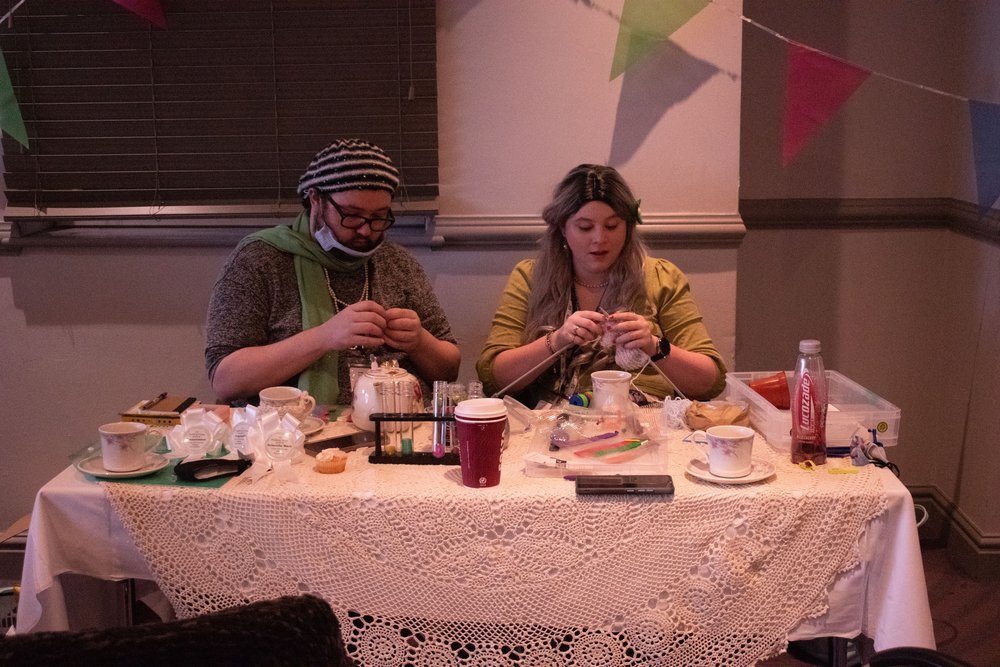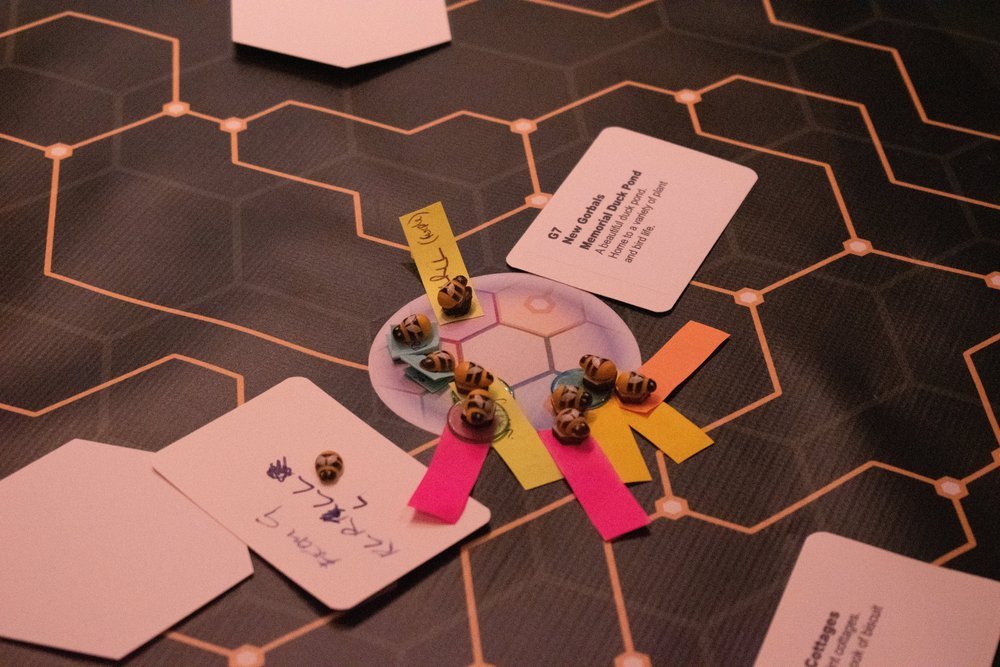Fête of a First Time Megagame Designer
Players interacting around a typically post-apolopytic village fête stall. Photo by: Robert Wall
Written by Holly Wall, the designer for Fête of the World, an in-person megagame about a typically English fête after the apocalypse. Here Holly puts forward four thoughts on her megagame and the design process.
Have you read the Maddaddam trilogy by Margaret Atwood? If you haven’t I highly recommend it. It’s got everything you could want: glow in the dark rabbits, weird religions, strippers with scales, and people surviving the apocalypse and figuring out what life looks like in a new and vastly different world. When I first started thinking about designing my own megagame that was my starting point. I wanted to create a game I would have a blast playing, even if I would never get to play it myself. Little did I know that writing and running Fête of the World would feel very much like surviving the apocalypse.
So for those of you who are thinking about writing your own megagame, imagine this is your future self-talking to you, freshly arrived in a ball of lightning, covered in battle scars and clutching a charred handbook, to tell you that what you are about to embark on will suck up so much more of your life and time (and money!) than you could possibly expect (1), and that whatever happens you MUST CONTINUE because it will be one of the most spectacular experiences of your life.
I should probably start with a bit about the game. While Margaret Atwood’s world was my starting point, the final game had far fewer strippers and far more baking. The basic premise of Fête of the World is this: a community of scientists move into a domed research facility just before the apocalypse. Safely sealed inside they quickly realise that they cannot leave and will need to make a new life where they are. 50 years pass and in that time the scientists have formed a small village community, complete with village greens, tea rooms, and an annual village fête. This year, being the 50th anniversary, is going to be extra special, so everyone is extremely excited.
So it might sound obvious, but this is my first piece of advice.
Knitting for England. Photo by Robert Wall
1) Make a game you would want to play
Fête of the World was never going to be everyone’s cup of earl grey. If you prefer historically accurate games involving armies and strategy, this one might not be for you. One thing I kept having to remind myself was that that’s ok. I have to assume that anyone who has chosen to come to a game about tea parties and Morris dancing won’t be disappointed to discover they do not have any tanks or troops (though the Bobbies did have secret mech suits which in the end were mostly used for frog transportation and confetti distribution).
For me a key part of making a game I would want to play was perfecting the setting. The megagames I have enjoyed the most have been those with a setting I was interested in and a character whose motivations I understood (I also like to have the option of getting dressed up in an absolutely ludicrous costume). I don’t think there is any way I would have stuck with writing this game if it hadn’t been for the fact that the concept just tickled me. I want to spend a week in the Dome. My aim was to set mechanics up so that the players could feel as though they were spending a day as a full part of that weird and wonderful community. This meant creating minigames which would fit into the flow of the story perfectly allowing for a seamless experience for everyone.
This brings me to piece of advice number two.
These bees appear to be lost. Can you help them? Photo by Robert Wall
2) Playtest the minigames
I would love to blame the real world apocalypse for the fact that I did minimal playtesting of the minigames, but the fact is that I am a chronic procrastinator and did not get my act together to actually get a few people together and run through it. The result of this was that on the day all of the games had elements which didn’t quite work. This was particularly evident in the one game which I had been reasonably proud of: the Bee Wranglers game.
I was extremely pleased with the idea of using the fact that bees dance maps to create an exploration game. Players would give their bees a ‘dance’ to follow, a simple list of instructions made up only of rights and lefts and the bee would follow the path they were given, uncovering areas of the map as they went. In retrospect I should have realised just how long that would take, and how likely it would be that in the players would mix up rights and lefts, or miss a junction when drawing their maps. Unfortunately, some of the things I wanted the players to discover over the course of the game were in parts of the map that no one had got near to by lunchtime.
Luckily for me I was blessed with the most wonderfully supportive and creative control team, all of whom helped to prop up mechanics that didn’t work and spin the players stories out into weird and wonderful directions. If it hadn’t been for those absolute stars the day would not have been what it was.
This next piece of advice is arguably the most important.
Thumbs up for a typically English fête. Photo by Robert Wall
3) Accept help
I am legendarily bad at this. That isn’t to say I didn’t get any help with this game. Far from it! Despite my brain’s best efforts I actually had a huge amount of assistance from True North Megagames, and in particular Seumas Bates. If it hadn’t been for Seumas badgering me to write, proofreading and editing everything, and not taking any of my excuses, the game just would not have happened (2).
The megagame community is full of people who want megagames to succeed, and want to be involved in them. I know this because I am one! If I could force myself to take one piece of advice on board it would be this: accept help from people when they offer it!! Things would have been so much easier if I had taken up people on their offers to write or design. I can’t tell you how many people offered me help throughout this whole process which I said I would accept while in the back of my mind knowing that in the end I just wouldn’t because it would mean exposing them to my chaos. The issue is that the longer you procrastinate the more you need help, but the harder it gets to ask for it. If I’m going to leave things to the very last minute, I really shouldn’t expect anyone else to give up sleeping. The real solution to that though is to accept the help early on and then everyone can sleep!
The night before Fête of the World I was up until the early hours of the morning still writing cards and literally emailing them to my wonderfully supportive husband who was printing them in the next room. I think I got to bed around 3am, then was up at 6am so we could get everything to the venue and set it up.
I. Was. A. Mess.
When my lovely cheery control team skipped in around 8am I was absolutely certain I was going to throw up on them. Luckily for everyone I was wearing a facemask. Thank you Covid!
We’re quite sure that no scheming is happening here. That just wouldn’t be on. Photo by Robert Wall
4) It will all be worth it
I don’t think I really started to breathe properly until two thirds of the way through the day. I have no idea what I said to anyone for most of the day.
There were boxes that didn’t work as expected. There were key players who couldn’t make it for unforeseen reasons. There were teams who took their briefs off in directions I didn’t expect and ended up sabotaging the Dome (I really should have anticipated that everyone would assume the A.I. was evil).
But somehow it was also one of the most rewarding experiences of my life. When it was over and I started breathing again it really was the most unbelievable high. Just sitting in the pub hearing about everyone’s schemes, plots, and theories was worth every sleepless night, every papercut, and every awkward conversation with a potential venue where I tried again to explain just what it was that I wanted to use their space for.
If you’re reading this you’ve already weathered an apocalypse. Time to get started on that game that’s been burning a hole in your brain. The world is changing, and one thing I definitely want to see in the post-pandemic world is more megagames.
The lovely Fête of the World players. Photo by Robert Wall
(1) Of course, it is also possible that you will be far better at time management than I am
(2) Piece of advice 3b: get yourself a megagame mentor who isn’t afraid to tell you to get over yourself!
We hope you enjoyed Holly’s four thoughts on her game. Is Holly right or is the real way to design megagmaes to stay up until 3am the night before it runs? Let us know your thoughts on our Facebook group.
We’re always looking out for folks to write for Megagame Assembly, so if you have thoughts on what makes a great megagame theme, or you’ve the best scone recipe this side of the apocalypse, let us know!






